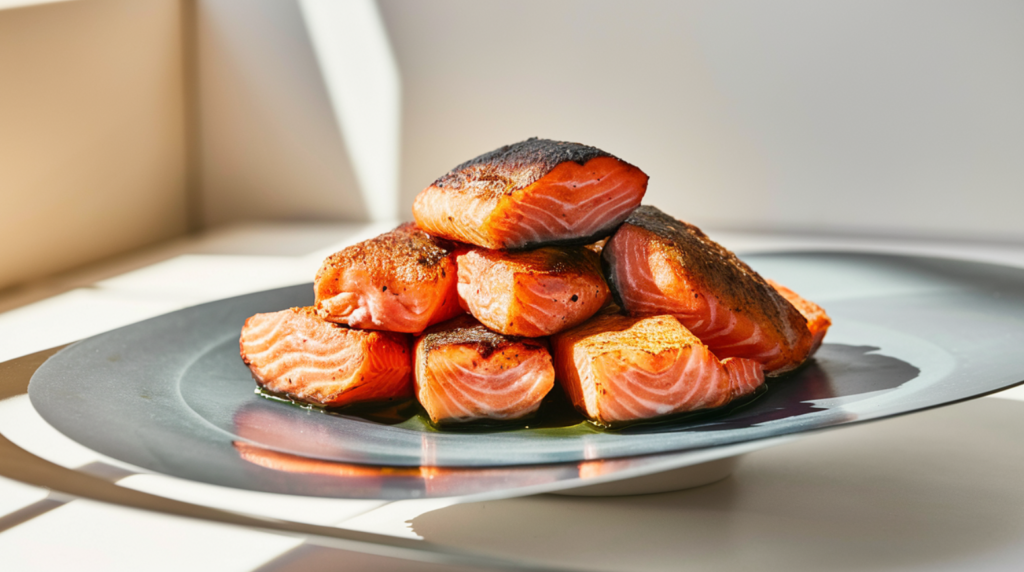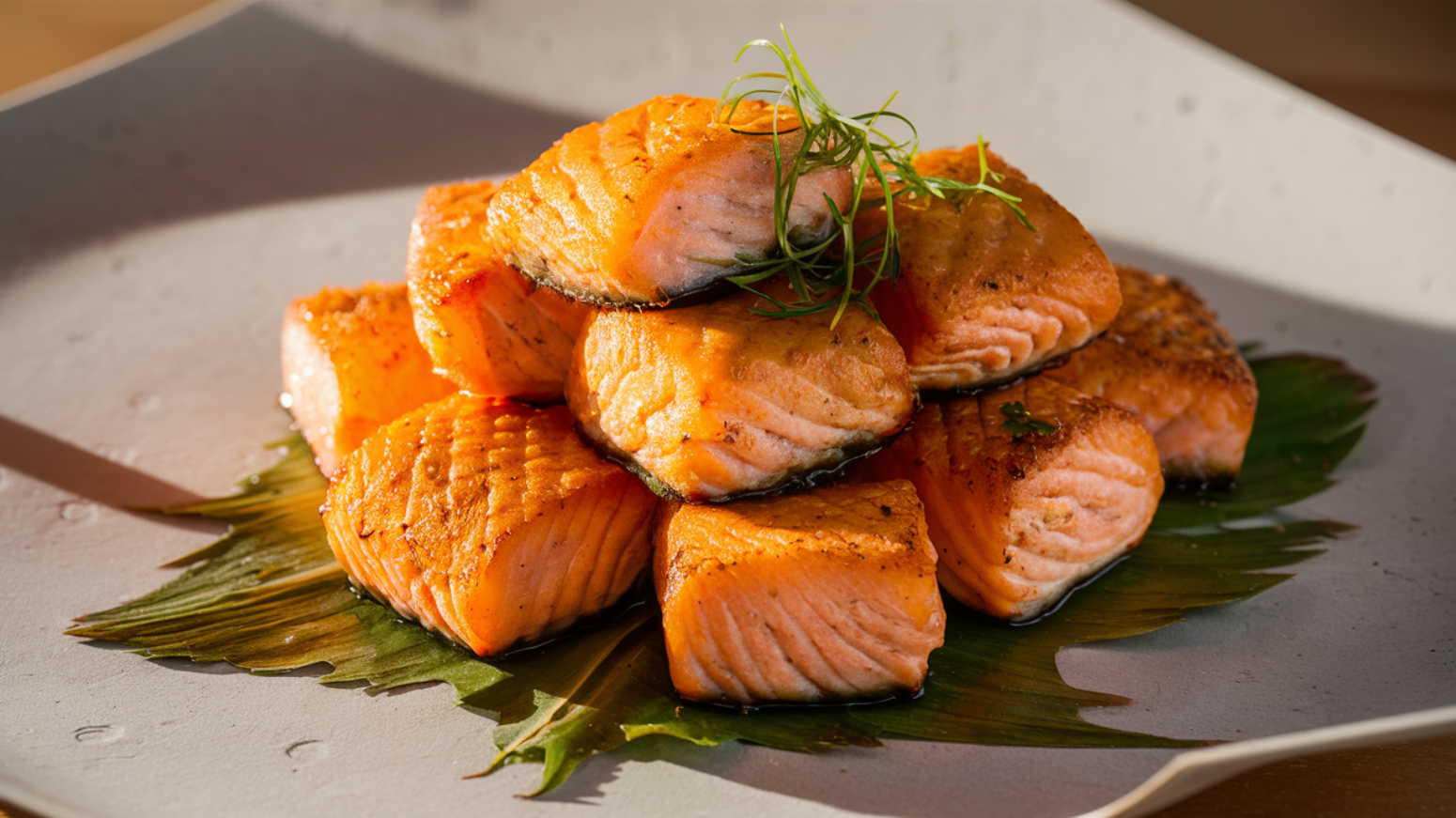Discover Irresistible Flavor with These Delicious Salmon Bites Recipes
Introduction
When it comes to appetizers or small bites, salmon is a versatile and crowd-pleasing option that can be transformed into delightful little morsels of flavor. Whether you’re hosting a dinner party, looking for a quick and nutritious snack, or want to impress your guests with an elegant dish, salmon bites are the way to go. Not only are they packed with heart-healthy omega-3 fatty acids, but they also offer a rich, buttery taste that pairs perfectly with a variety of seasonings and dips.
In this blog post, we’re going to dive deep into the world of salmon bites. We’ll explore different ways to prepare them, provide detailed instructions, and offer tips for making them as flavorful as possible. By the end of this guide, you’ll be equipped with all the knowledge you need to create the most delicious salmon bites you’ve ever tasted.
Why Salmon Bites?
Salmon bites have gained popularity for several reasons. They’re easy to prepare, cook quickly, and are perfect for any occasion. Whether you’re throwing a casual get-together or a formal dinner, salmon bites can be dressed up or down to suit the event. They’re also incredibly versatile—you can make them crispy, baked, grilled, or even raw (think sushi-style), depending on your preference.
But beyond their adaptability, salmon bites are also a healthier choice. Salmon is a rich source of omega-3 fatty acids, which are known for their anti-inflammatory properties and benefits for heart health. Plus, it’s packed with high-quality protein, vitamins, and minerals, making it a nutritious option that doesn’t compromise on flavor.
Ingredients
Before we get into the nitty-gritty of making salmon bites, let’s gather all the ingredients you’ll need:
- Salmon: Fresh, boneless, and skinless salmon fillets work best for salmon bites. Aim for about 1-1.5 pounds.
- Olive Oil: For drizzling and pan-frying.
- Salt and Pepper: To taste.
- Lemon: Zest and juice of one lemon for a fresh, tangy flavor.
- Garlic Powder: About 1 teaspoon for a subtle garlic kick.
- Paprika: Adds a mild heat and a smoky flavor.
- Dill: Fresh dill is ideal, but dried will work too. You’ll need about 2 tablespoons.
- Soy Sauce or Tamari: For a savory, umami-rich marinade.
- Honey or Maple Syrup: To balance the savory elements with a touch of sweetness.
- Optional Toppings: Sesame seeds, fresh herbs, or a sprinkle of chili flakes for added flair.
Preparing the Salmon
- Choose the Right Salmon: Selecting fresh, high-quality salmon is the first step in ensuring your bites are delicious. Wild-caught salmon tends to have a richer flavor and firmer texture compared to farm-raised varieties. Make sure the fillets are bright, with a clean scent—these are indicators of freshness.
- Cutting the Salmon: Begin by patting the salmon fillets dry with a paper towel. This will help the seasonings stick better and give you a nice, crispy exterior if you’re pan-frying. Using a sharp knife, cut the salmon into 1-inch cubes. Try to keep the pieces uniform in size so they cook evenly.
- Marinating the Salmon: In a mixing bowl, whisk together olive oil, lemon juice, garlic powder, paprika, dill, soy sauce (or tamari), and honey (or maple syrup). Add a pinch of salt and pepper to taste. Toss the salmon cubes in the marinade until they’re well-coated. Let them marinate for at least 15-20 minutes—this allows the flavors to penetrate the fish and makes each bite extra tasty.
Cooking Methods
One of the great things about salmon bites is that you can cook them in a variety of ways depending on your preference and equipment. Here are a few methods to consider:
1. Pan-Frying
Pan-frying is a quick and easy way to achieve crispy, golden-brown salmon bites. Heat a skillet over medium-high heat and add a drizzle of olive oil. Once the oil is hot, carefully place the salmon bites in the pan. Cook for 2-3 minutes on each side, or until the outside is crispy and the inside is opaque. Be careful not to overcrowd the pan—cook in batches if necessary.
2. Baking
If you prefer a hands-off approach, baking is a fantastic option. Preheat your oven to 400°F (200°C) and line a baking sheet with parchment paper. Arrange the salmon bites on the sheet in a single layer and bake for 10-12 minutes, flipping halfway through. This method results in tender, juicy salmon bites with minimal effort.
3. Grilling
For a smoky flavor, grilling is the way to go. Preheat your grill to medium-high heat and lightly oil the grates. Thread the salmon bites onto skewers (if you’re using wooden skewers, soak them in water for 30 minutes beforehand to prevent burning). Grill for 3-4 minutes on each side, or until you see grill marks and the salmon is cooked through.
4. Air-Frying
Air fryers are becoming increasingly popular for their ability to create crispy foods with less oil. Preheat your air fryer to 375°F (190°C) and place the salmon bites in the basket in a single layer. Cook for 8-10 minutes, shaking the basket halfway through to ensure even cooking. This method is perfect if you’re looking for a healthier alternative to deep-frying.

Dipping Sauces
No salmon bite is complete without a delicious dipping sauce. Here are a few options to consider:
1. Lemon-Dill Yogurt Sauce
Mix together plain Greek yogurt, fresh lemon juice, chopped dill, and a pinch of salt. This tangy and creamy sauce pairs beautifully with the rich flavor of the salmon.
2. Spicy Sriracha Mayo
Combine mayonnaise, Sriracha, and a squeeze of lime juice for a spicy, zesty dipping sauce that adds a kick to your salmon bite.
3. Honey Mustard
Whisk together Dijon mustard, honey, and a splash of apple cider vinegar for a sweet and tangy sauce that’s sure to please.
4. Teriyaki Glaze
For an Asian-inspired twist, try a teriyaki glaze. Combine soy sauce, honey, garlic, and ginger in a small saucepan. Simmer until thickened, then drizzle over the salmon bite.
Serving Suggestions
Salmon bites are incredibly versatile and can be served in a variety of ways. Here are some ideas to inspire you:
- Appetizer Platter: Arrange the salmon bites on a platter with a selection of dipping sauces and garnishes like lemon wedges, fresh herbs, and sesame seeds. This makes for an impressive and delicious starter at any gathering.
- Salad Topping: Add your salmon bites to a fresh green salad for a protein-packed meal .They pair especially well with mixed greens, avocado, cucumber, and a lemon vinaigrette.
- Tacos: Fill soft tortillas with salmon bites, shredded cabbage, avocado, and a drizzle of spicy mayo for a quick and flavorful meal.
- Rice Bowl: Serve your salmon bites over a bed of steamed rice with roasted vegetables and a sprinkle of sesame seeds for a satisfying and nutritious dinner.
- Sushi-Style: If you’re a fan of sushi, serve the salmon bites on top of sushi rice with a touch of wasabi and soy sauce.
Tips for Perfect Salmon Bites
- Don’t Overcook: Salmon cooks quickly, so keep an eye on it. Overcooking can result in dry, tough bites. Aim for a juicy, tender interior.
- Use Fresh Ingredients: Fresh herbs, citrus, and high-quality salmon will make a noticeable difference in the final dish. Don’t skimp on these key ingredients.
- Experiment with Flavors: While this recipe offers a delicious base, feel free to get creative with your seasonings and marinades. Salmon pairs well with a wide range of flavors, from citrus and herbs to soy sauce and spices.
- Serve Immediately: Salmon bite are best enjoyed fresh and hot. If you’re cooking for a crowd, consider cooking them in batches and serving them as they’re ready.
Nutritional Benefits of Salmon
Salmon isn’t just delicious—it’s also a nutritional powerhouse. Here’s a quick look at some of the key health benefits:
- Rich in Omega-3 Fatty Acids: These essential fats are known for their heart-protective properties. They help reduce inflammation, lower blood pressure, and decrease the risk of heart disease.
- High in Protein: Salmon is an excellent source of high-quality protein, which is essential for muscle growth, repair, and overall body function.
- Loaded with Vitamins: Salmon is a great source of B vitamins, which play a crucial role in energy production, brain function, and DNA repair. It’s also rich in vitamin D, which supports bone health and immune function.
- Packed with Minerals: Salmon provides important minerals like selenium, which helps protect cells from damage, and potassium, which helps regulate blood pressure.
Conclusion
After all salmon are a delicious, versatile, and nutritious option that can be enjoyed in countless ways. Whether you’re hosting a dinner party, preparing a weeknight meal, or just looking for a quick snack, these little bites of flavor are sure to impress. With the right ingredients, a few simple cooking techniques, and a selection of tasty dipping sauces, you’ll have a dish that’s not only satisfying but also packed with health benefits.
So, what are you waiting for? Gather
Look at the FAQS for more ideas
1. Can I use frozen salmon for salmon bites?
Yes, you can use frozen salmon, but make sure to thaw it completely and pat it dry before cooking to ensure the best texture and flavor.
2. How do I store leftover salmon bites?
Store leftover salmon bites in an airtight container in the refrigerator for up to 3 days. Reheat them in the oven or air fryer for the best results.
3. Can I make salmon bites ahead of time?
Yes, you can prepare the salmon bites ahead of time and store them in the fridge for up to 24 hours before cooking. This allows the flavors to marinate even more.
4. What dipping sauce goes best with salmon bites?
Lemon-dill yogurt, spicy Sriracha mayo, and honey mustard are popular options that complement the rich flavor of salmon.
5. Are salmon bites healthy?
Yes, salmon bites are a healthy option as they are rich in omega-3 fatty acids, high-quality protein, and essential vitamins and minerals.
6. Can I make salmon bites gluten-free?
Yes, simply use gluten-free soy sauce (or tamari) and check your other ingredients to ensure they are gluten-free.
7. What’s the best cooking method for crispy salmon bites?
Pan-frying and air-frying are the best methods if you want crispy salmon bites. Just make sure not to overcrowd the pan or basket.

